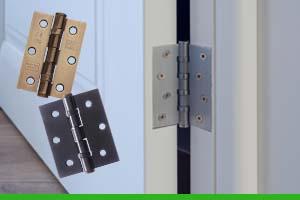How to fit door hinges
How to fit door hinges

Door hinges are highly important to everyone’s daily lives. They are essential to open entrance doors, car doors, cabinet doors and even jewellery boxes. Hinges are a type of joint which attaches two pieces together to allow for limited movement.
There are various types of hinges available with different types of strengths and purposes. They are made with different materials and finishes to meet any requirements. Our best-selling hinges are ball bearing hinges, such as stainless steel ball race hinges, antique brass ball bearing hinges and black nickel ball bearing hinges. This type of hinge is equipped with a ball bearing, which reduces friction, being ideal for interior doors.

The type of door will also be an important aspect when purchasing door hinges. To support lightweight internal doors, two hinges will usually be enough, however, heavier doors will require at least three hinges. Additionally, if you have french doors or any other type of door which you’ll want to fully open flat against the wall, we would recommend purchasing parliament hinges. This guide will help you understand how to fit standard hinges.
Materials
- Hinges
- Door wedge
- Pencil
- Tape measure
- Hammer
- Chisel
- Drill
- Screws
Instructions
Step 1. Firstly, you’ll want to measure the position where you are going to install the hinges. Use a door wedge to hold the door in place to get an exact position. If you are fitting two door hinges on a lightweight door, the lower hinge should be fitted 9 inches from the bottom of the door and the upper hinge should be fitted 6 inches from the top of the door – use a pencil to mark these measurements. If you have to fit three door hinges, place the third hinge midway between the top and bottom hinge.
Step 2. Hold the door hinge on your measured mark and draw a line at the top and bottom of the hinge on both the door frame and door itself. This will give you the perfect position where the hinge will sit.
Step 3. Remove the door and place it on its side. Hold each hinge on their marked position and draw around the hinge flap with a pencil. To mark the depth of the hinge, hold it level with the edge of the door and mark the depth with a pencil.
Step 4. Slowly use a chisel and hammer vertically to start cutting the edges of the hinge, then make a series of cuts along the length of the hinge to the depth you’ve marked. Chisel sideways to remove the depth of the wood. Do step 3 and step 4 to the door frame as well.
Step 5. Fit the hinges in the recess and trim any further if required. Drill pilot holes for the screws on both the door frame and door. Firstly, screw the hinges into the door first and then screw the hinges in the frame. Test the door to see if it closes smoothly.

And that’s it – you’ve fitted door hinges perfectly. If you have any enquiries regarding our selection of door hinges available or any other ironmongery product, feel free to email our team at info@ironmongeryexperts.co.uk or call us on 01376 557 561.
Disclaimer
At Ironmongery Experts we strongly advise that you always take safety precautions into consideration when undertaking a DIY project. We also strongly suggest that you closely read and follow the instructions provided by the manufacturer of any building materials, products or tools you use for your projects.
We try our best to provide clear and correct instructions within our articles, so you can easily complete any DIY project you desire. However, please note that the information we provide should only be used as a guideline and that some information within the text may not be entirely accurate.
When using our articles for information and advice, please note that is your own responsibility to determine your capabilities when undertaking and executing the task you wish to complete.
Before starting a DIY task, we strongly recommend that you educate yourself of any existing building, gas, water and electrical works regulations. We believe it is in your best interest to complete further research and/or contact the necessary professional body should you have any further concerns.
We also strongly recommend that a qualified tradesperson completes the relevant safety tests and checks on any DIY you have completed.





